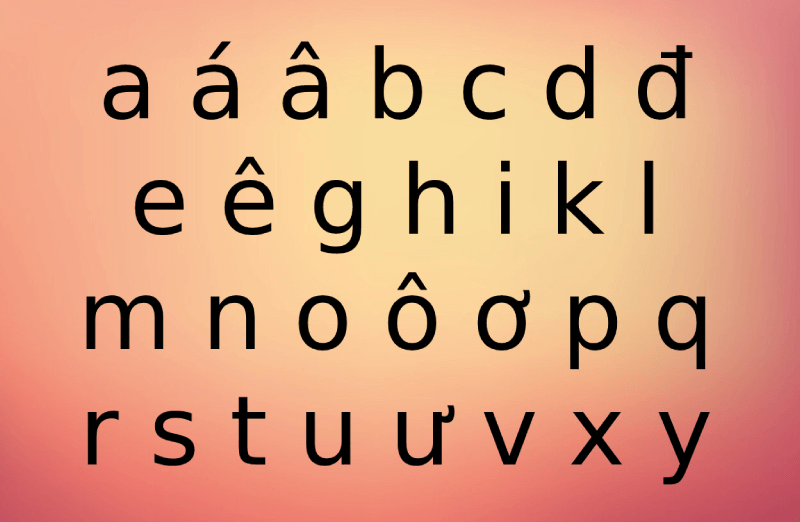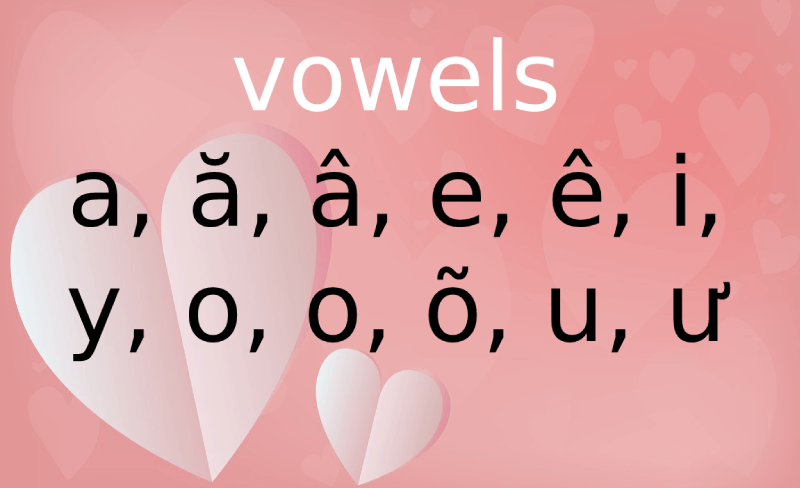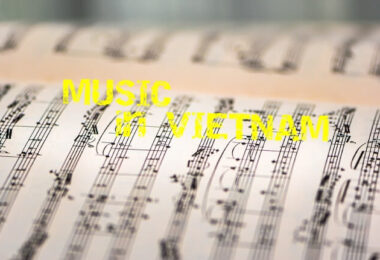The Vietnamese alphabet is a system of characters, letters, and accents or diacritics that learners need to memorize to read and write Vietnamese fluently.
Learning the pronunciation rules of the alphabet is an extremely important step to better understanding Vietnamese.
Unlike English, each letter in the Vietnamese alphabet can be read only one way. Still, when diacritics are added, they can make another sound.
Here, let’s learn more about the Vietnamese alphabet.
- Structure of the standard Vietnamese alphabet
- Vowels in the Vietnamese alphabet
- Consonants in the Vietnamese alphabet
- The diacritics or accents in the Vietnamese alphabet
1. Structure of the standard Vietnamese alphabet
According to the standards of the Ministry of Education, the Vietnamese alphabet has 29 letters and 5 diacritics.
The letters of the alphabet in Vietnam have two forms of writing: normal/lowercase and capital/uppercase.
- Uppercase letters are also called large capital print.
- Lowercase letters are also called small letters.
Summary of names and pronunciation of Vietnamese letters:
| No | Normal Letter | Capital Letter | Name | Pronoun |
| 1 | a | A | a | a |
| 2 | ă | Ă | á | á |
| 3 | â | Â | ớ | ớ |
| 4 | b | B | bê | bờ |
| 5 | c | C | xê | cờ |
| 6 | d | D | dê | dờ |
| 7 | đ | Đ | đê | đờ |
| 8 | e | E | e | e |
| 9 | ê | Ê | ê | ê |
| 10 | g | G | giê | giờ |
| 11 | h | H | hát | hờ |
| 12 | i | I | i/i ngắn | i |
| 13 | k | K | ca | ca/cờ |
| 14 | l | L | e-lờ | lờ |
| 15 | m | M | em mờ/e-mờ | mờ |
| 16 | n | N | em nờ/ e-nờ | nờ |
| 17 | o | O | o | o |
| 18 | ô | Ô | ô | ô |
| 19 | ơ | Ơ | ơ | ơ |
| 20 | p | P | pê | pờ |
| 21 | q | Q | cu/quy | quờ |
| 22 | r | R | e-rờ | rờ |
| 23 | s | S | ét-xì | sờ |
| 24 | t | T | tê | tờ |
| 25 | u | U | u | u |
| 26 | ư | Ư | ư | ư |
| 27 | v | V | vê | vờ |
| 28 | x | X | ích xì | xờ |
| 29 | y | Y | i/i dài | i |
In addition to the traditional letters, many people use four modern letters borrowed from the English alphabet to table the Vietnamese alphabet, including f, w, j, and z. These letters are not officially recognized in Vietnam.
An example of using the four letters is the “Z” in the word “Showbiz,” the “F” in the word “Cafe” or “FIFA,” “J” in “DJ,” and the “W” in “WTO” or “WHO.”
2. Vowels in the Vietnamese alphabet
In the latest Vietnamese alphabet, there are 12 single vowels: a, ă, â, e, ê, i, y, o, o, õ, u, ư. There are also three diphthongs with many specific spellings, such as ua – uô, ia – yê – iê, ưa – ươ.
Here are some important characteristics that learners need to note about how to read the above Vietnamese vowels as follows:
- a and ă are two vowels. They have nearly the same reading from the basis of the tongue’s position to the mouth’s opening and pronunciation.
- Two vowels, ơ and â, are nearly similar, but the ơ sound is a little longer than the â sound.
- For vowels, accented vowels are ư, ơ, ô, â, ă need special attention. These sounds need to be studied well for foreigners because they are harder to pronounce.
- In writing, all single vowels appear alone in syllables and do not repeat in the same position near each other. Unless a few words from the minority groups or borrowed from another language, such as Xoong, means pot or Son Doong Cave.
- The sounds “ă” and “à” do not stand alone in Vietnamese writing.
3. Consonants in the Vietnamese alphabet
Most consonants are recorded with a single letter: b, r, t, s, v (in Võ Thuật – Martial Arts), etc. In addition, there are nine consonants written with two letters. Specific compound forms such as:
- Ph: found in words like – phim (movie) and phở (noddle).
- Th: found in words like – thong thả (leisure), thức ăn (food).
- Tr: in words like – tre (bamboo), trâu (buffalo).
- Gi: in words like – gia sư (tutor), giá (price or bean sprout),
- Ch: in words like – cha (father), chú (uncle).
- Nh: in words like – nhẹ nhàng (gentle), nhạc cụ – meaning Vietnamese instrument.
- Ng: in words like – ngày (day), ngầy (thin).
- Kh: in words like – không khí (air), khó (difficult).
- Gh: in words like – ghế (chair), ghi chép (a record).
Typically, in the Vietnamese alphabet, there is a consonant combined with three letters: Ngh – used in words nghề nghiệp (career), nghiêng (inclined).
Besides, three consonants have the same pronunciation when standing in different letters. They are the consonant /k/ that is recorded with:
- K when standing in front of i/y, iê, ê, e (eg: kí/ký, kiên cường …);
- Q when standing in front of a semi-vowel u (e.g., qua, quoc, que…)
- C when standing before the remaining vowels (e.g., cá, cơm, cốc…)
The consonant /g/ is recorded with:
- Gh when standing in front of the vowels i, iê, ê, e (e.g., ghi, ghiền, ghê,…)
- G when standing before the remaining vowels (e.g., gỗ -ưood, ga – station, …)
Consonant /ng/ is recorded with:
Ng when standing in front of the remaining vowels (e.g., ngư -fish, ngã -fall, ngón tay -finger…)
Ngh when standing in front of vowels i, iê, ê, e (e.g., nghi thức- ceremony, nghe – listen)
4. The diacritics or accents in the Vietnamese alphabet
Currently, in the Vietnamese script, there are 5 diacritics: dấu sắc – sharp mark (´), dấu huyền – grave accent (`), dấu – hỏi – the question mark (ˀ), dấu ngã – tilde (~), dấu nặng – under dot (.)
Rules for placing diacritics in Vietnamese:
- If there is a vowel in the word, put the accent right in the vowel (Example: ú, ngũ, ngã, bà…)
- If there are two vowels in a word, type the diacritic in the first vowel (e.g., của cải – property, ngày – day).
- Note that for some words like “quả” (fruit) or “già” (old), then “qu” and “gi” are the resulting diphthong vowel, which combines with one vowel, “a.” So, put the diacritic on “a.”
- If there are three vowels, the diacritic will be on the second vowel (for example, khuỷu tay – elbow).
- If a word has a vowel “ê” and “ơ,” the diacritic is a priority on it (e.g., “tiếu” – fun, thuở – age).







